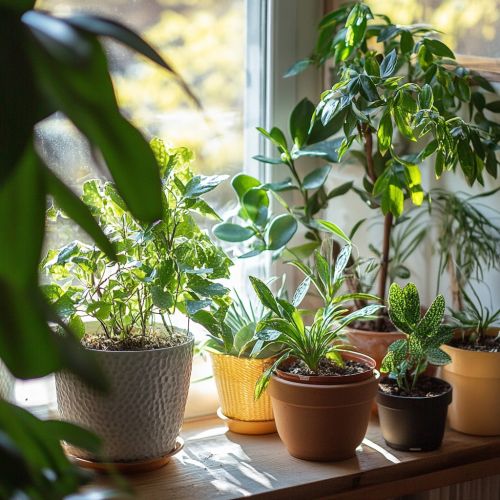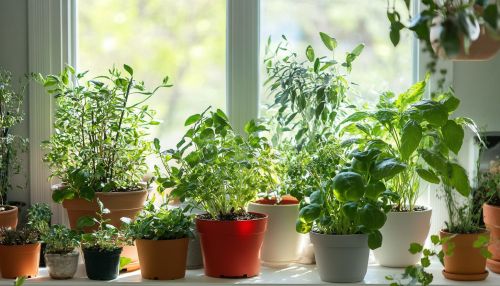Indoor gardening: Difference between revisions
(Created page with "== Introduction == Indoor gardening is the practice of growing plants within a building, such as a home, office, or other enclosed space. This method of gardening allows for the cultivation of a variety of plants, including ornamental plants, herbs, vegetables, and fruits, regardless of outdoor weather conditions. Indoor gardening can be pursued for aesthetic, culinary, or therapeutic purposes, and it often involves the use of specialized equipment and techniques to opti...") |
No edit summary |
||
| Line 94: | Line 94: | ||
== References == | == References == | ||
[[Image:Detail-97989.jpg|thumb|center|Indoor garden with various plants in pots on a windowsill.|class=only_on_mobile]] | |||
[[Image:Detail-97990.jpg|thumb|center|Indoor garden with various plants in pots on a windowsill.|class=only_on_desktop]] | |||
[[Category:Gardening]] | [[Category:Gardening]] | ||
[[Category:Horticulture]] | [[Category:Horticulture]] | ||
[[Category:Indoor plants]] | [[Category:Indoor plants]] | ||
Latest revision as of 00:57, 15 September 2024
Introduction
Indoor gardening is the practice of growing plants within a building, such as a home, office, or other enclosed space. This method of gardening allows for the cultivation of a variety of plants, including ornamental plants, herbs, vegetables, and fruits, regardless of outdoor weather conditions. Indoor gardening can be pursued for aesthetic, culinary, or therapeutic purposes, and it often involves the use of specialized equipment and techniques to optimize plant growth.
History of Indoor Gardening
The concept of indoor gardening dates back to ancient civilizations. The Hanging Gardens of Babylon are one of the earliest examples of large-scale indoor gardening. In ancient Rome, atriums and courtyards were often filled with plants. During the Victorian era, indoor gardening became popular in Europe, with the introduction of conservatories and greenhouses. The development of modern technology has further advanced indoor gardening, making it more accessible and efficient.
Types of Indoor Gardens
Container Gardens
Container gardens involve growing plants in pots, planters, or other containers. This method is versatile and allows for easy relocation of plants. Containers can be made from various materials, including plastic, ceramic, and terracotta.
Hydroponic Systems
Hydroponics is a method of growing plants without soil, using nutrient-rich water solutions. This system can be highly efficient and is often used in commercial indoor farming. There are several types of hydroponic systems, including nutrient film technique (NFT), deep water culture (DWC), and aeroponics.
Vertical Gardens
Vertical gardens, also known as living walls, involve growing plants on vertically suspended panels. This method maximizes space and can be used to create green walls in urban environments. Vertical gardens can be either hydroponic or soil-based.
Terrariums
Terrariums are small, enclosed environments for growing plants. They are typically made of glass and can house a variety of plant species. Terrariums can be open or closed, depending on the type of plants and the desired humidity levels.
Essential Elements of Indoor Gardening
Light
Light is a critical factor in indoor gardening. Plants require light for photosynthesis, the process by which they convert light energy into chemical energy. Indoor gardeners often use artificial lighting, such as LED grow lights, to provide the necessary light spectrum for plant growth.
Temperature
Maintaining an appropriate temperature is essential for indoor gardening. Most plants thrive in temperatures between 65°F and 75°F (18°C to 24°C). Temperature fluctuations can stress plants and affect their growth.
Humidity
Humidity levels can significantly impact plant health. Most indoor plants prefer humidity levels between 40% and 60%. Humidifiers and dehumidifiers can be used to regulate humidity levels in indoor gardens.
Soil and Growing Mediums
The choice of soil or growing medium is crucial for indoor gardening. Soil-based gardens require high-quality potting soil, while hydroponic systems use inert growing mediums like coconut coir, perlite, or rockwool.
Nutrients
Plants need a balanced supply of nutrients to grow. Indoor gardeners often use liquid or granular fertilizers to provide essential nutrients, such as nitrogen, phosphorus, and potassium. Hydroponic systems require specific nutrient solutions tailored to the plants being grown.
Common Indoor Plants
Ornamental Plants
Ornamental plants are grown for their aesthetic appeal. Common indoor ornamental plants include ficus, dracaena, peace lily, and pothos.
Herbs
Herbs are popular in indoor gardens due to their culinary uses. Common indoor herbs include basil, thyme, rosemary, and mint.
Vegetables
Growing vegetables indoors can provide fresh produce year-round. Common indoor vegetables include lettuce, tomatoes, peppers, and carrots.
Fruits
Some fruits can be successfully grown indoors, especially in larger spaces or with the use of dwarf varieties. Common indoor fruits include citrus fruits, strawberries, and figs.
Techniques and Best Practices
Watering
Proper watering is essential for indoor gardening. Overwatering and underwatering can both harm plants. It is important to understand the specific water needs of each plant species and to use well-draining containers.
Pruning
Pruning helps maintain plant health and shape. It involves removing dead or diseased leaves, stems, and flowers. Regular pruning can also encourage new growth and improve air circulation around the plant.
Pest Control
Indoor gardens can be susceptible to pests such as aphids, spider mites, and fungus gnats. Integrated Pest Management (IPM) strategies, including biological control, cultural practices, and chemical treatments, can help manage pest populations.
Pollination
Some indoor plants require pollination to produce fruits. Hand pollination can be done using a small brush or by gently shaking the plants. Certain plants, like tomatoes, benefit from the use of electric pollinators.
Propagation
Propagation is the process of creating new plants from existing ones. Common methods of propagation include seed starting, cuttings, division, and layering. Understanding the propagation techniques suitable for each plant species is important for successful indoor gardening.
Challenges and Solutions
Limited Space
Limited space is a common challenge in indoor gardening. Solutions include using vertical gardening techniques, selecting compact plant varieties, and utilizing multi-tiered shelving.
Light Availability
Insufficient natural light can hinder plant growth. The use of artificial grow lights can supplement natural light and provide the necessary light spectrum for photosynthesis.
Temperature and Humidity Control
Maintaining optimal temperature and humidity levels can be challenging. Using thermostats, humidifiers, and dehumidifiers can help create a stable environment for plants.
Pest Management
Indoor gardens can attract pests, which can be difficult to manage in a confined space. Regular monitoring, proper sanitation, and the use of natural predators or organic pesticides can help control pest populations.
Benefits of Indoor Gardening
Health and Well-being
Indoor gardening can have positive effects on mental and physical health. It can reduce stress, improve air quality, and provide a sense of accomplishment. The presence of plants has been shown to enhance mood and productivity.
Fresh Produce
Growing herbs, vegetables, and fruits indoors provides access to fresh, homegrown produce. This can contribute to a healthier diet and reduce reliance on store-bought produce.
Aesthetic Appeal
Indoor plants can enhance the aesthetic appeal of living and working spaces. They add color, texture, and life to indoor environments, creating a more pleasant and inviting atmosphere.
See Also
References


